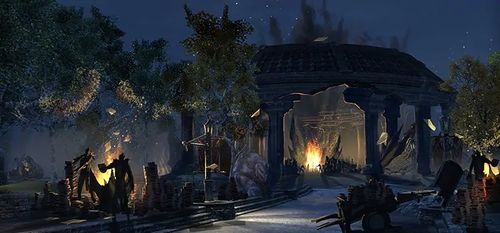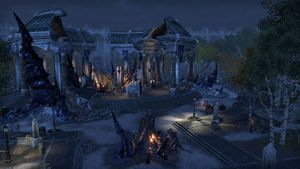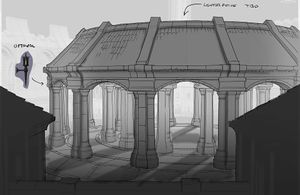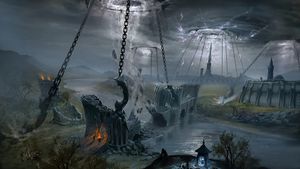The original article was posted here on August 4, 2015
You've likely gazed upon the beauty of the White-Gold Tower while on your travels across Tamriel. That familiar structure marks the center of the Imperial City, the capital of Tamriel, which resides in the heart of Cyrodiil. And in just a few weeks, you'll be able to visit the capital city when it's released with the Imperial City DLC game pack. In preparation of your forthcoming journey, we wanted to pull back the curtain and discuss the recreation of this new, yet familiar zone, while explaining how we're providing an experience far different than anything you've seen before in ESOTU.
It's no secret that we've been hard at work on creating the Imperial City for quite some time. When we began its development, we knew that you would immediately feel a sense of nostalgia upon revisiting the capital—after all, your first steps in The Elder Scrolls IV: Oblivion were spent escaping the city's prison. But things have certainly changed now in the Second Era—remember that ESOTU takes place prior to the events in Oblivion.
 |
Our first order of business was to set the timeline. Your arrival comes two months after the city and its inhabitants have been taken hostage by the Worm Cult. From a development standpoint, it was crucial for us to make that clear at first glance. To succeed, we implemented drastic visual differences to the zone to help emphasize that it's now a city under siege. Some structures have been destroyed; others are in a state of ruin. Imperials are enslaved, and monsters roam the streets. Whether you're brand new to Tamriel or a returning adventurer, we think you're really going to love the reimagined zone.
(The video can be found here.)
Since the city and its districts existed prior to their inclusion in ESOTU, it was easy for us to recreate the basic layout of the Imperial City based on the general design found in Oblivion. We did take some liberties, such as expanding the size of the Imperial Sewers to allow for more room in your alliance's home base. Above ground, we needed to emphasize that this is a completely different time with very real threats that have quickly shaped the region. A great example of those changes is the Arboretum district; we've designed each district to have its own theme, and the Arboretum is no exception. Those familiar with the terrain will remember that the Arboretum resides at the southeast portion of the city. This visually striking area houses a central pagoda that in later years will hold a statue of Emperor Tiber Septim as seen during the time of Oblivion. In ESOTU, the crumbling pagoda is now the stage for a massive book burning. Daedra have gathered books from within the city to set them ablaze—you'll learn more about this on your adventure. It's quite a different sight to see compared to the serenity found at the pagoda prior to the invasion.
As with creating all content within the game, we needed to make sure that we delivered a satisfying experience while playing through the Arboretum. During our internal employee playtests, however, we found that our early iterations featured too many quests. It was to the point where it was fairly difficult to know what was going on with the overall story—and we're the ones who developed the content! We ended up reducing the number of quests to seven, which allowed for us to focus on telling the tale of what has happened to the Imperial City in a clear way while giving each district its own distinct story. But we still needed a hook that would also guide you through the content. To help tie the quests together, we decided to introduce the character Drake of Blades (a precursor to the Blades, notable in the Third Era.) Her role was to keep the story intertwined between the districts by helping you disrupt the assault on the city. She quickly became a favorite character around the studio, and we hope you feel the same during your quest.
Another aspect that took some iteration was determining just how difficult we wanted this content to be. After plenty of internal playtests, we determined that the content should be scaled for groups of two players—though a highly skilled player could take on the zone by themselves if they're feeling up to a serious challenge. The end result is an unforgiving zone that will satisfy those who aren't afraid of entering the fray. After all, the streets are riddled with Daedra who have no intention of letting you off easy for infiltrating their new home.
While monsters will certainly be out for blood, let's not forget that much of the Imperial City landscape is a full on PvP warzone. Watching your back against enemy alliances is key to your survival. To help maximize the threat of enemy alliance players, we wanted to implement a new mechanic that would make players fear being killed—something that hasn't been seen before in ESOTU. We decided to introduce the Tel Var Stone system, an in-game currency that is used exclusively in the Imperial City to redeem Veteran armor sets. We found that implementing this new system added even more weight to death, as you'll feel a serious loss when dying in battle. The rush you'll feel when narrowly escaping enemy alliance players who are out to get your hard-earned Tel Var Stones is one we think you're going to crave.
As we mentioned before, our internal employee playtests brought about a great deal of feedback that helped to shape the content that you'll come to play. The Imperial City has content for both PvE and PvP playstyles, but we wanted to add new experiences that would help the zone stand out. One new addition is the way we changed enemy encounters. Initially, the zone was riddled with too many enemies. It became clear we needed to rework this in order to focus on making it a more fun and enjoyable experience. To mix it up, we reduced the amount of monsters and increased the respawn timer, which offered the perfect balance of challenge, difficulty, and reward.
We also added larger scaled enemies, like the Flesh Colossus, that require a group to defeat. These enemies appear as random threats within the districts—they shake up the playing field at a moment's notice. We found that adding these bigger enemies also helped encourage players to work together, which ramped up the fun. Lastly, we decided to try something new by turning off the enemy leashing mechanic completely, a first for us in this game. Leashing restricts NPCs to a specific area, preventing them from following players past a designated point if they try to escape from battle. Turning off this system introduced a welcome bit of chaos that we think you'll appreciate.
There's plenty to do and see in the Imperial City, and we've only scratched the surface. For PC/Mac players, you can test the DLC game pack on our public test server (PTS) now, and provide your feedback on the official ESOTU forums. The Imperial City DLC game pack will arrive on PC/Mac on August 31, Xbox One on September 15, and PlayStation®4 on September 16. We look forward to seeing how you fare against the many challenges that eagerly await your arrival in the capital city!



